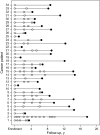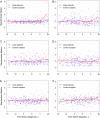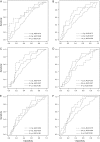Assessing lead time of selected ovarian cancer biomarkers: a nested case-control study
- PMID: 20042715
- PMCID: PMC2802285
- DOI: 10.1093/jnci/djp438
Assessing lead time of selected ovarian cancer biomarkers: a nested case-control study
Abstract
Background: CA125, human epididymis protein 4 (HE4), mesothelin, B7-H4, decoy receptor 3 (DcR3), and spondin-2 have been identified as potential ovarian cancer biomarkers. Except for CA125, their behavior in the prediagnostic period has not been evaluated.
Methods: Immunoassays were used to determine concentrations of CA125, HE4, mesothelin, B7-H4, DcR3, and spondin-2 proteins in prediagnostic serum specimens (1-11 samples per participant) that were contributed 0-18 years before ovarian cancer diagnosis from 34 patients with ovarian cancer (15 with advanced-stage serous carcinoma) and during a comparable time interval before the reference date from 70 matched control subjects who were participating in the Carotene and Retinol Efficacy Trial. Lowess curves were fit to biomarker levels in cancer patients and control subjects separately to summarize mean levels over time. Receiver operating characteristic curves were plotted, and area-under-the curve (AUC) statistics were computed to summarize the discrimination ability of these biomarkers by time before diagnosis.
Results: Smoothed mean concentrations of CA125, HE4, and mesothelin (but not of B7-H4, DcR3, and spondin-2) began to increase (visually) in cancer patients relative to control subjects approximately 3 years before diagnosis but reached detectable elevations only within the final year before diagnosis. In descriptive receiver operating characteristic analyses, the discriminatory power of these biomarkers was limited (AUC statistics range = 0.56-0.75) but showed increasing accuracy with time approaching diagnosis (eg, AUC statistics for CA125 were 0.57, 0.68, and 0.74 for > or = 4, 2-4, and <2 years before diagnosis, respectively).
Conclusion: Serum concentrations of CA125, HE4, and mesothelin may provide evidence of ovarian cancer 3 years before clinical diagnosis, but the likely lead time associated with these markers appears to be less than 1 year.
Figures




Comment in
-
Designing early detection programs for ovarian cancer.J Natl Cancer Inst. 2010 Jan 6;102(1):3-4. doi: 10.1093/jnci/djp450. Epub 2009 Dec 30. J Natl Cancer Inst. 2010. PMID: 20042718 Free PMC article. No abstract available.
Similar articles
-
Influence of ovarian cancer risk status on the diagnostic performance of the serum biomarkers mesothelin, HE4, and CA125.Cancer Epidemiol Biomarkers Prev. 2009 May;18(5):1365-72. doi: 10.1158/1055-9965.EPI-08-1034. Cancer Epidemiol Biomarkers Prev. 2009. PMID: 19423517 Free PMC article.
-
Evaluation of the novel serum markers B7-H4, Spondin 2, and DcR3 for diagnosis and early detection of ovarian cancer.Gynecol Oncol. 2007 Jul;106(1):112-8. doi: 10.1016/j.ygyno.2007.03.007. Epub 2007 May 8. Gynecol Oncol. 2007. PMID: 17490732
-
HE4 and mesothelin: novel biomarkers of ovarian carcinoma in patients with pelvic masses.Asian Pac J Cancer Prev. 2010;11(1):111-6. Asian Pac J Cancer Prev. 2010. PMID: 20593939
-
SMRP and HE4 as biomarkers for ovarian carcinoma when used alone and in combination with CA125 and/or each other.Adv Exp Med Biol. 2008;622:15-21. doi: 10.1007/978-0-387-68969-2_2. Adv Exp Med Biol. 2008. PMID: 18546615 Review.
-
Diagnostic value of human epididymis protein 4 compared with mesothelin for ovarian cancer: a systematic review and meta-analysis.Asian Pac J Cancer Prev. 2012;13(11):5427-32. doi: 10.7314/apjcp.2012.13.11.5427. Asian Pac J Cancer Prev. 2012. PMID: 23317195
Cited by
-
EPIC Early Detection of Ovarian Cancer.Clin Cancer Res. 2016 Sep 15;22(18):4542-4. doi: 10.1158/1078-0432.CCR-16-1391. Epub 2016 Jul 14. Clin Cancer Res. 2016. PMID: 27418634 Free PMC article.
-
Optical quantification of cellular mass, volume, and density of circulating tumor cells identified in an ovarian cancer patient.Front Oncol. 2012 Jul 18;2:72. doi: 10.3389/fonc.2012.00072. eCollection 2012. Front Oncol. 2012. PMID: 22826822 Free PMC article.
-
The inhibitory role of b7-h4 in antitumor immunity: association with cancer progression and survival.Clin Dev Immunol. 2011;2011:695834. doi: 10.1155/2011/695834. Epub 2011 Oct 13. Clin Dev Immunol. 2011. PMID: 22013483 Free PMC article. Review.
-
Validation of a Biomarker Panel and Longitudinal Biomarker Performance for Early Detection of Ovarian Cancer.Int J Gynecol Cancer. 2016 Jul;26(6):1070-7. doi: 10.1097/IGC.0000000000000737. Int J Gynecol Cancer. 2016. PMID: 27206285 Free PMC article.
-
Integrative proteomic analysis of serum and peritoneal fluids helps identify proteins that are up-regulated in serum of women with ovarian cancer.PLoS One. 2010 Jun 15;5(6):e11137. doi: 10.1371/journal.pone.0011137. PLoS One. 2010. PMID: 20559444 Free PMC article.
References
-
- Etzioni R, Urban N, Ramsey S, et al. The case for early detection. Nat Rev Cancer. 2003;3(4):243–252. - PubMed
-
- Jacobs IJ, Menon U. Progress and challenges in screening for early detection of ovarian cancer. Mol Cell Proteomics. 2004;3(4):355–366. - PubMed
-
- Bast RC, Urban N, Shridhar V, et al. Early detection of ovarian cancer: promise and reality. Cancer Treat Res. 2002;107:61–97. - PubMed
-
- Zurawski VR, Orjaseter H, Anderson A, Jellum E. Elevated serum CA 125 levels prior to diagnosis of ovarian neoplasia: relevance to early detection of ovarian cancer. Int J Cancer. 1988;42(5):667–680. - PubMed
Publication types
MeSH terms
Substances
Grants and funding
LinkOut - more resources
Full Text Sources
Other Literature Sources
Medical
Research Materials
Miscellaneous

